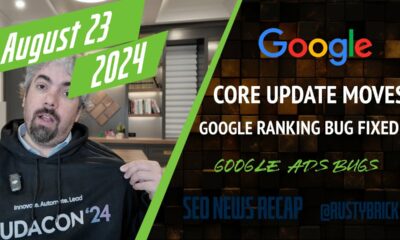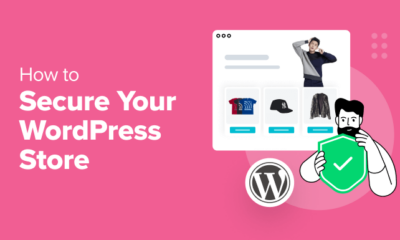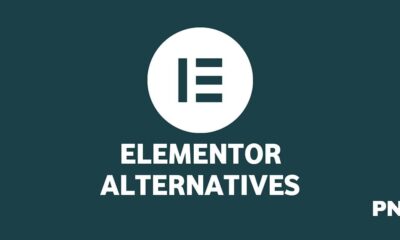AFFILIATE MARKETING
How Shane Dutka Makes Millions From Lead Generation & Affiliate Offers

Want some unique insights on what’s working for high-earning affiliate and lead gen sites today?
Shane Dutka joins Niche Pursuits podcast to discuss his journey from an accountant to a successful site owner making $50k+ per month.
He discusses how he’s sold sites for 7-figures, and what he does now to grow sites as VP of SEO for a company generating $100-200 million from lead generation and affiliate offers!
You’ll learn the interesting story of how he got into the business and how he’s consistently grown successful sites faster than most.
He shares how to uncover a keyword goldmine through data analysis and tracking conversions on affiliate platforms.
Plus, how he’s managed to compete even in tough niches like jewelry by focusing on the fundamentals of high-quality content and links. And Shane is very generous with tips on what strategies you can use to get both!
Shane shares invaluable insights on serving diverse user avatars and the SEO benefits that come along with this. He emphasizes the significance of matching keyword intent and targeting one keyword per page and sheds light on the importance of fresh content and routinely updated to maintain relevance.
He also shares how he builds engaging, newsworthy content for successful link-building, which is helpful to mitigate the potential pitfalls of paid links.
When discussing paid links, Shane shares strategies to overcome toxic links with the use of 410 and 404 pages. And really a ton of helpful and actionable tips and tactics to help sites of all sizes grow.
So don’t miss this awesome episode.
You’ll learn what’s working today, from someone with unique access to massive data and exactly what you as an independent site owner can do to grow and profit!
Topics Shane Dutka Covers
- How he got into building sites
- Why SEO was a good fit
- His bowtie eCommerce site
- Pivoting into building affiliate and lead generation sites
- How he found a unique voice in various niches
- Linking out to authoritative sources
- Information gain
- Growing to $50k+ per month
- How he sold his pest control site for over $1 million
- His content creation process
- Tracking conversions
- How to leverage experts even if they can’t write
- Picking affiliate programs
- Combining affiliate and lead generation opportunities
- Content freshness
- Buying links
- Hub pages
- Why you should 404 or 410 pages with bad links
- And a whole lot more…
Links & Resources
This Episode is Sponsored by Search Intelligence
Watch The Interview
Transcription
Jared: All right. Welcome back to the Niche Pursuits Podcast. My name is Jared Bauman and today we’re joined by Shane Duck. Shane, welcome on board.
Shane: Thanks for having me.
Jared: It’s good to have you here. You came highly regarded, highly referred, I should say, but also highly regarded probably, but in the same there.
Mm-hmm. Uh, I’m really excited for what we’re gonna be talking about today. You have a great past. In website building and, uh, we’re gonna get to hear a lot of the stories of websites you’ve built and sold and what you’re doing now. Um, let’s start off by you telling us some of your background. I, I, I know I kind of teased a little bit of what you’ve been doing, but maybe give us even, even further back if you can.
Shane: Yep. Yeah, so my background, uh, originally from New Jersey, I studied being an accountant. Uh, I was gonna do the whole, you know, traditional nine to five routes a lot of people take, uh, I went to school for, for, uh, business administration, accounting moms, university, if anybody’s familiar. And, um, yeah, I graduated in 2013, passed the CPA exam, was like, I’m ready to do this accounting thing.
And, uh, did it for about five years. From 2013 to 2018, I moved to Virginia to, to actually go do a job out of, outta my state and away from my, my family, which was sort of a, you know, leap of faith. But I, I’m glad I did that. Um, I did that for about. Three years for 2313 to 2016. And I knew pretty quickly that it was not the long term PLA path for me.
Accounting is not. I’m glad I did it cuz like I learned a lot about business, the nuts and bolts of like, you know, balance sheet, income statement p and l, all of that. Um, so that’s really valuable knowledge and I am grateful for that. But it. You know, as an accountant, you’re for businesses look at accountants as like overhead, right?
Nobody wants to pay their accountant more money, uh, to like do better accounting. So you’re not really like part of like generating revenue for a business. So I wasn’t really, I. I knew that and I, and I knew if I wanted to have a really, you know, I wanted to create some real wealth for myself, I had to probably start my own business or do something like that.
Mm-hmm. So my ba, my dad was an electrical contractor. He, uh, was sort of a, very much a workaholic, a little bit. Um, and I’d taken a little bit from that, from him, but he was, he started his own business doing electrical contracting. And I was like, I had that entrepreneur intramural spirit in me a little bit, and I was like, you know what?
Digital seems like the right place for me to sort of work on the side, do my job, nine to five job as an accountant. And then also, Uh, do something in, in the digital world where I can like do it remotely. So I started an e-commerce business in 20 16 20 17, selling bow ties. And I picked bow ties because it was a super lightweight product, easy to ship.
It seemed like a good idea. There was like the most boas thing on Shark Tank that was like, ah, this kid can do it. I can do it. So I started, I threw my hat in the ring. I did like a Shopify site. I literally took all of my savings, which was like about 25 k at the time, and like 10 k, 20 k of credit card debt and like bought.
5,000 bow ties from China. I, uh, went to Upwork to get a few of them designed and just sent it all over to China. And I was like, buy it. And I, I went through Alibaba and the whole thing, and they, um, they came, you know, I, I basically just jumped, dumped all my money and like burned the boats. I was like, I’m gonna figure this thing out.
And uh, and of course, uh, of course it, I had no money left over for actual, like, marketing and I wasn’t a marketer. I was the whole accountant. I was like, literally day during the day, I’m like, how would I reconcile these checking accounts? And then I have to go. Two freaking, uh, my, my like internet, you know, we’ll pull up the laptop and be like, okay, how am I sell bow ties today?
Meanwhile, my whole room is full of bow ties. Like literally my whole room I was at in an apartment with four other dudes and there was bow ties all over the house. They were not, none too pleased about that. And, uh, so that was ex, that was fun and also extremely stressful. And, uh, not a gr I would say a little bit of a darker time.
You know, a lot of people talk about entrepreneurship. It’s all up and until the right, it’s really not. This was a, probably a more darker time. Cause I was doing a big shift in my lifestyle and I didn’t have a lot of money to do it with. So I, um, out of desperation, I was like, I gotta sell these freaking bow ties.
So I learned, I was like, how do, how can I market this stuff? And I can’t pay for ads, so what all, what our options are relevant for me. You know, you can go viral on like something like that. But I wasn’t very creative. But, um, I was very analytical, so I was looking for things like that. And SCL really caught my eye and I was like, oh, I can do some content marketing.
I went to one conference and I started rubbing elbows with some people. Like Brock at Modest Man, he, we went to this, uh, conference called, um, influential at the time. It was then, uh, renamed, like, uh, it was actually Stylecon, it was a couple different names for it, but it was a conference where a bunch of men who were like in marketing came together to discuss marketing stuff.
And one of them was Brock and he had his blog. And I was like, oh, you know, like I’m a short guy. You’re a short guy. We should be friends. Like, and he like gave me some tips around seo and I was like, okay. And then I implemented them into the bow tie site. I, uh, published an article called Bow Ties with Suits and that ranked and I was like, oh, snap.
Okay, this is working. Uh, I’m actually getting money, but it’s like bow ties. So like the niche is super narrow, not very, uh, the MSV is extremely limited, so there’s not a lot of people searching for bow tie stuff, so it’s not gonna change my life. And not, I’m not, I’m not really selling that many bow ties.
In general. I was making maybe one two k a a month, um, at like the highest peak of right of my bow tie life. And this was around 2017 and, uh, all this debt and stuff. And I was like, all right, this isn’t working. I need to pivot. So I knew the content thing was working. I knew SEO was working and it was again, the site was actually called be the bow tie guy.com.
Still online. So if you’re curious, you actually go to the site and see it and my face is around, there’ll be pictures of me, like in the corner of my house taking. Like pictures of me in a bow tie for the site. So, uh, very scrappy, uh, did what I had to do, you know? And uh, but I ended up pivoting to affiliate and I was like, let me sell someone else’s product.
Cuz like I was literally emailing people at like 12:00 AM in the morning that were like in like Dubai, Hey dude, where’s my bow ties? I’m like, I don’t have time to res be doing customer service for, for bow ties. Uh, you know, it’s just not, this is not sustainable. It’s not gonna make me create the lifestyle that I wanna live.
So I, um, I ended up doing, I pivoted and I ended up taking a course, which I know there’s like, sort of mixed, mixed feelings about courses and internet marketing. There’s certainly plenty of crappy ones out there. Um, the one I took was, um, Gale and Mark Authority Hacker. There’re pretty well known in the community and the SEO community at the time, they were still kind of new-ish.
They were like just getting started. But I was like, these guys know what they’re talking about. I’m like, looking at their blog. I’m like, they seem legit. So I took their thing and I kind of combined what was working for me in the bow tie thing, and then like my own perspective on how I was, uh, how I, when I went through their course, it was like, okay, what niche could I enter that?
I think there’s really low competition. I know seo, so I feel like I can create content and I can like have a new voice in the niche. And pest control really rose to the top. A lot of products to promote. There was a lead gen component, so you can like do something with like local pest companies. Uh, an affiliate platform called Networks is one where you can just sign up and they’ll like, give you a widget.
You can like sell leads through networks. And that’s what I did. Again, there’s a ton of products to promote with pest and I knew people hated pests and then there’s a lot of people googling about that. So I ended up pivoting to pest control and um, did. Uh, basically just sorted that this was 2017, around February and I, uh, published, I don’t know, 30.
I wrote them all myself. So I’m an expert bedbug removal. Guy, if you need to learn how to kill bedbugs, like I’m your guy. I know the, the tips and tricks. Um, which is great. My wife loves that. And, uh, and then yeah, fast forward maybe six months, I started to see some traction. I started to see some of these articles ranking.
I was like, oh, okay, this is working, getting some, making some money. And this is like summertime, so it’s like sort of pie season for pest control, making some money, uh, through Amazon affiliate. Um, and I think we’re probably at about maybe like 500 to a thousand, probably like closer 500 bucks a month right now.
About six months in. Uh, but then fast forward a year, so around spring of 2018, the next, the next full spring, you know, if we’re like thinking like ups and downs, um, I continued to publish Icontinue to link building. Uh, I did all my own. I ri wrote all my own content probably up until 50 pieces. Then I outsourced.
I used Upwork and Pro Blogger. To find, uh, writers that have niche expertise, and I’m a big, I’m a big advocate of that. You need somebody who’s actually done the work. Um, not some just like, like blogger who can like research like everyone else can do. Like especially today’s day and age with like AI content, you really do need a unique voice to like stay ahead of the curve.
At the time in 2017, it was probably a little easier, but, uh, I highly recommend doing that and that’s what I did. So I hired a guy on Pro Blogger for about 6 cents a word. Uh, to do niche, niche writing. Actually emailed, I also emailed pest control companies. I was like, Hey, does any of your pest control guys like wanna write?
And I got like one or two bites and one guy who’s I like you
Jared: did there by the way, the, the bites that’s, uh, well played. Nice pun.
Shane: Yeah. Yeah. Thanks for that. I, yeah, totally intentional. I, uh, I, uh, I got one bite and the guy was like the kookiest nice guy, but super kooky, like who do you sort of expect in your mind’s eye about somebody who like their whole life in pest control and, uh, knew everything there is to know about pest control, but was a terrible writer.
Which is usually the, the objection I get when I’m like, Hey, go to pro or fire, find, uh, nit checks. Writers, usually people are like, well, they’re gonna be terrible writers, cuz they’re like, just their expertise. And I’m like, yes, that’s true. But be really, be a really hard ass editor. Give them an outline. Be like, you have to follow this header and just give ’em feedback.
They will get, there may be a little slower in the beginning, but this guy eventually got there and ultimately, I, I thought the content he produced was good. So, fast forward to 2018 spring, I’m now, I’ve now grown to probably, definitely over a hundred thousand sessions a month. Uh, $10,000 per month. Uh, the site, it was pest strategies.com.
I can reveal the domain. It doesn’t matter. Um, cause the site is now sold like two or three times over, so it’s not like three hands away from me. But, um, yeah, we, we, I grew it to 10,000 bucks a month, just straight doing exactly what I just mentioned. And, uh, at this point in time, I’m still an accountant, by the way.
This is 2018, still doing accounting on the side. Uh, the bow tie thing is still happening. I still own the site, so I’m still shipping bow ties at night, but I’m really not doing anything else except shipping bow ties. Dude, I learned so much about e-commerce with this boat, even though it made no money. I learned all about the, the operations of an e-commerce organization.
Like, like, uh, logistics. Like I had a guy, I called the guy. To like freaking get his truck to go to like LA and like load up the freaking truck with all the pack, you know, things that Emmy, Amazon FBAs had to deal with, uh, just people in E-com have to deal with. So I learned all about that and then I was very happy to sell it in 2019 to the guy.
I actually, I literally had to count every single bow tie to do a proper inventory before I sold the business. Mm-hmm. And, uh, me and my wife literally watched Dexter for like seven straight seasons, whatever, how many scenes they have, just counting bow ties. It was. Kind of fun, but also kind of like, I don’t know, you know what I mean?
So, uh, yeah, 2018 we’re at 10,000 bucks a month, PET strategies, and I walked to my boss’s office. I’m like, Hey, look. I’m quitting, you know, like I’m making tons of money from pest control. I don’t know what I’m doing here. So, uh, and then fast forward another year, it’s still CABG growing up until the right hit 50 K a month.
Uh, Amazon display ads, leg gen. That was the three sort of corner like pe wave ways of monetizing. And um, you know, a lot of people ask me like, dude, what did you do? How did you, how did you hit those? Like how did you hit that? Like milestone? Those were really big. And there was like a cohort of people I started with at the time that.
I, we were on the phone calls like every month and I would be a little awkward cause I’d be like, I don’t wanna be like bragging or anything. I’m just like, this is what the numbers are. I’m like, they’re at fi, I’m doing, dude, I’m gonna do 20 K this month. And, and they’re like, what the fuck? How are you doing that?
What is happening? Let me go to your site and see. And um, really I think it’s just having that unique voice, knowing the niche. I just knew, uh, what people cared about. Cause I did so much research. I was like, people really, moms. Care about the chemicals, like the insect, like the actual active ingredients.
So a lot of my articles spoke to the active ingredients, but no other articles did. So I was like, Hey, if you’re gonna get this bedbug spray, the active ingredient is like, Ima Prosci, or whatever. I can’t even say the word, but it’s like one of those chemical ingredients. And by the way, here’s what like research says about that, you know, and linked out to that.
Um, Google says, or I’ve seen a number of case studies where like, linking out to authoritative sources can help you, you know, you, uh, rank well on Google and I think that was part of it for sure. So anyway, we’re at 50 k a month now, and I’m like loving life. It’s totally ch it’s literally totally changed my life.
I have gone from accounting, the digital, and I’m like starting other sites now. I started a jewelry site, uh, and, uh, that one, I, I ended up growing that one to like 2030 k a month. Um, that was called learning jewelry.com. Uh, and basically same thing, like I found somebody who’s an expert at jewelry and I said, here’s your outline.
And I was like, we need to make sure people, like when they come to our articles, they feel like they’re getting a unique perspective. Um, I think Steve Toth, uh, and a few other people are bringing this, this, of this concept of like information gain, which is like, what are, what is the other nine Blue Links saying?
And what are you saying? And is there anything being added to the conversation? I always try to instill that in all my content. So I had this pest control site, I had a jewelry, so I had like three or four more. Uh, and sorry, I’m like rambling on a ton right now. If you have, you have like questions like feel free.
Oh, I got a lot. Okay. You just let me know when you’re ready. Let me just finish the jewelry and then I’ll stop talking and like maybe take some water. Um, no problem. So then jewelry site, and then I, I ended up selling that one to Empire Flippers, uh, and their, their whole like capital program, which was really cool.
I got to experience that. Um, meanwhile, while during this whole span of time, I bought a fitness site and sold it within the first month I bought it. I, uh, sold, I bought a baby b, uh, a baby site, and then merged it into another baby site I was playing around with just to see what would happen. Um, I ended up selling PET strategies for over a million dollars, uh, on FE International, uh, in 20 19th of September.
That was fun and also super duper stressful. It was my first sale, uh, and especially at that dollar range. I didn’t know what I was doing. I, um, was always weighing private first going to market, and I ended up going with the market place just cuz to have some seller representation. And, uh, I do think I made some money on Made.
I would’ve, I I went down the right path on that. Um, cuz I did have some private options, but I just didn’t know what the hell I was doing. So they helped me navigate that. Um, it ended up being like a seller financing deal, so definitely some interesting things I could probably talk about there. And then, um, and then, yeah, the jewelry site that was started in 2019.
I sold that one in 2021. Uh, and then I started a few more here and there. And then I joined up with this company called Three Ships. So that’s where we are today. Uh, I started with them in 2020. I’m now VP of seo. I oversee all of their owned and operated assets on their home business line. Mm-hmm. Uh, home, we do north of like a hundred to 200 million across three ships.
Uh, mostly through affiliate. It’s like 95% affiliates. So we are, we like to say like the big leagues of affiliate and if like anybody’s listening now and you’re like, oh yeah, that sounds like an interesting thing. Like, and you want a job and you’re good, I am always willing to talk to really great SEOs that.
Wanna do this full-time and uh, you know, might wanna work together. So anyway, I’ll stop talking there. That’s kind of brings you to today and, um, happy to jump into anything specifically.
Jared: Well, let’s be clear. Out of what you went through, you summarized what a lot of us would hope to accomplish in a lifetime, and you’ve done in less than five years.
Or six years, whatever it is. It’s pretty, it’s a pretty phenomenal, um, resume and I’m really excited to, to kind of drill into some of these things, which, uh, let me, let, let me ask you this question. Of the different projects that you’ve started online and you’ve exited online, Which one do you think applies the most to today and today’s online environment?
Because you spoke about a lot of the changes in mm-hmm. 2017 different than 20, 23 and, yep. 20 and, and you know, all the different things that are happening with the way Google wants content to be with ai, with all those things, like, which project of yours do you think is the most representative of a success in today’s Google environment?
Shane: Hmm. That’s a good question. I, um, I think so Pest strategies has gone through a number of hands. And I think that the hands it has gone through weren’t the best hands. So I think if I were, I would say when I sold pest strategies, the day I sold it was, it was in its best shape. Cuz I was like, super, I was all over it, you know?
A hundred percent. I would say if you roll the clocks back to like September of 2019, that version of pest strategies, Is what I would rebuild today. Mm-hmm. The current version of Pest Strategies is not the version I would build today. It is a mess. Uh, it’s, it’s just, I think the people who bought it just deprioritized it.
Um, and it, it’s, it’s just like that version in 2019 is the most representative. And the reason I say that is, Every article had this like in active ingredient sort of angle to it, which I think again helped the site stand out in Google’s eyes like, oh, this is something different that not, doesn’t exist on every article.
They’re bringing a unique perspective. They also have links like the, the site did not have links. It had a bunch of links. So like it had that powering it. But I think when you couple a decent domain authority with a unique perspective, I think you put yourself in a really great position to succeed. And, um, I think we, I think I did a good job with that, with that site at that time.
Yeah.
Jared: Were there other things about the way that you wrote the content besides just this active ingredient? Because it, like you, you sound very passionate about the topic of test control. I always love getting people on. No, it’s true though. But it’s, it’s fun cuz I always love getting people on and you’re like, it’s easy to be passionate about, you know, football.
And um, uh, cuz it’s a passionate hobby, right? And you, we talk about hobby niches and how it’s really fun, but I love talking with people who kind of go into niches that aren’t fun, right? Um, oh yeah. Uh, whatever. Pest is probably a good one. Like no one gets outta bed in the morning and goes, man, I just. Get me to my pest control project later today.
That’s just what I’m living for. Right? Yeah. So, but you have, but at the same time, I hear a heart and a passion in your voice for what you produce. Like what are other things do you think you brought to the table besides just including information about certain products? Like what other things can people learn from that you brought to the table and the content you created?
Yeah.
Shane: You know what? I think you say it like, Hey Shane, your passion, it sounds like you’re passionate about pest control. I think I was passionate about making money. Cause like I saw that as a great vector for that. I was like, yeah, I, I think there’s a massive gap in this quality content site, in the pest control niche.
And that’s what I brought and that’s what made me excited about working on it. And, um, I thought bringing on those expert writers, the guy from the pest control, uh, uh, company that I found, um, which by the way, I hired him for like 5 cents a word. Maybe even le, maybe even 4 cents a word. Which is like crazy low.
But he wasn’t trying to sell, he wasn’t trying to make money being a writer. He just was like, I’ll just do it in my free time. I’m not gonna make money doing it otherwise, you know, it’s like, so that’s a great negotiating position cuz like he’s just doing it cuz he has the knowledge and I just give him like a, I just channel his knowledge in a certain way, a content template brief.
And that worked out really well. I think. Um, yeah, I think I just get really jazzed about the, uh, just the opportunity that I had and like the, The way, it just, I think the passion just comes from like liking, having a lot of, um, what’s the word? Uh, A very much an ownership mentality, I guess is the best way I can put it.
Like I, when I built something, it’s me, you know, like I, I put my best foot forward. I put a lot of time and energy into it. I, I did my own branding at the time. I used Thrive Architects, so some of your listeners might know that suite of tools. Really? They were sort of in, in, in vogue at the time. Oh yeah.
They were like all about Thrive around 2017. Super out of vote now. Um, it’s all about bricks, Jerry Blocks now. It’s like a whole totally different world. All a mentor obviously is still like, you know, somewhere in there. And, um, And yeah, I built it with like these page builders, which people are like, how could you possibly build it with a page builder so slow?
It still works cuz it kind was good. So I think for me, like the passion comes from just like working on a project and like bringing something unique to the market and feeling really, um, good about that. You know? And I think that’s just, that’s probably where it comes from. It’s hard to explain. It’s explain.
Yeah, we
Jared: interviewed someone a while back who, who kind of said like, their, their benchmark before they hit publish every time was they would reread the article and try to imagine that they were the user arriving on that article with their question in mind and would they be satisfied with the answer.
And it sounds like a pretty basic thought. Well, of course I wrote the article, but, but just kind of trying to go at it from that standpoint, um, was I, I think it’s a good reminder and it’s a good benchmark for people like, you know, do you care about the results you’re putting out there? And clearly you did.
And
Shane: clearly it worked. Yeah. Yeah, I think that’s right. So
Jared: one trend or pattern I can see is that with all of these brands that you started, you had a quick runway to success. You know, like the pest site was at 10 K a month. What, a year and a half in. Yeah. Um, the jewelry site, uh, et cetera, et cetera. Like, I’d love to hear some details from you, whether it’s uh, keyword research, digital pr, link building, whether it’s something specific about the way you go about building sites that allow them to get traction quicker than what we were probably used to seeing.
Shane: Yeah. I’m just making notes. I wanna make sure I cover those things. Uh, yeah, I think, um, I think the reasons that they were successful were different. So pest strategies was successful because the, the competitors were very weak. There were some sites, if you’re curious, pest wiki.com, look up in the archives.
That was a total trash site. It looked like a site that was built purely for affiliate, which Google, we know Google doesn’t love, may win in the short term, but long term it’s probably gonna get loose. Uh, So PE Wiki was one and I saw that was like the, that was like the average was like PE Wiki and I was like, I can beat these guys.
So I think the competition was super low. Um, it was relatively under the radar, the niche. So most, the keywords are pretty easy to target and um, uh, I think it’s different today. I think there’s definitely more competition, pretty much all niches, but that one in particular, Uh, so the competition was a bit lower, uh, and that was why I was able to slide in there.
Had a unique content angle. I did do link building, I think better than the competition as well. Um, I got a couple really key links that I think were like the cornerstone links, as you would say in a link profile. Like I got a link from malaria.com. I got a link from like, uh, lodging magazine, which is about hotels, and they talked about pest controls, like a perfect fit.
Um, got a bunch of links from like apartment therapy before HAR was really like really popular. I got links from apartment therapy. I got links from like Bustle. So these, these really powerful media sites that weren’t doing really hard at the time were able to like, prop up this link profile, mix that with good quality content.
And then you saw this like crazy spike. And I think that’s why, I think it’s why it worked. Um, my content was also very formulaic. You know, people, some people have mixed feelings about Brian Dean. I think he does a really good job of like simplifying, uh, SEOs sometimes. Like he can maybe like gloss over some of the nuance, which some seo, you know, uh, Like some of SEOs be like, feel like, oh, you’re missing some of the points here, and I get that.
But I think Brian Dean does a good job of saying, Hey, here’s like the 80 20 seo. Like put the keyword here, put it in your header, put it three times here. Like, and I kind of followed that and I followed it pretty closely among, as well as like the authority hacker, uh, sort of model. And um, I saw some really good results from that.
And I think I have my analytical mind just like fit really well into the seo, uh, landscape. So that was, um, That was pest strategies and then learning jewelry. The reason that one was successful was very much keyword research. Jewelry was definitely not an easy niche like it was. There’s so many jewelry sites, you gotta compete with e-commerce sites.
There’s a ton of e-com jewelry sites that are dominating landscape. There’s a site called Diamonds Up Pro, which is like dominating every keyword. That site probably makes like a hundred K a month at least, uh, maybe more. It’s, it’s literally. Dominating the niche, but I saw them and I was like, at the time I was looking for the next niche and I was looking for, uh, opportunities that weren’t just pure Amazon sites.
I was like, what? What? Um, and I would usually go like Impact, I’ll go to uh, uh, uh, uh, share sale. I’ll go to Avant Link or these like platforms. We’ll just skim through the offers cj.com and be like, what offers map to like niches? And then I’ll just like Google terms and be like, best hair dryer. Best. Uh, one that I was thinking about was, um, Like wigs.
I was like, I wonder if wigs is a niche. Like I wonder if wigs could be good. It’s all like best wigs. And then, and I’ll be like, who’s ranking there? And I’ll be like, how big are they? So I’ll like do that kind of like bottoms up approach or maybe it’s top down, I don’t know. But I did that for diamonds and I saw, um, I think I saw G either James Allen or Blue Nile in one of the platforms.
And I was like, Hmm, best diamonds and let’s see what that looks like. And then, uh, and then I saw diamonds.pro and I was like, Hmm, let me see what else. So you see how like that goes down a thread? Of like research. Mm-hmm. Like, okay. Okay. And you could sort of see their content strategy and you’re like, all right, all right, I see where, where this is going.
And then, and then what really clicked was that, well, I saw the offers they were promoting, which was like non-Amazon offers. They had Blue Nile, James Allen, you know, Ritani, uh, k K, you know, the big names in the industry. Yeah. And then, uh, one other thing I saw that really interests me about that site was that, um, oh, when I started, so that, like, that got me into jewelry.
And then when I was doing research. Uh, for keywords, I, I went down this path of like, where to buy x, uh, where to buy x, where best place to buy X or best comp. Sorry, it was best company for X or something like that. Right? And that was a unique spin on the whole best thing. Yeah, and diamonds is actually a really bad niche for like traditional, like best vacuum cleaner, best diamond.
Like it’s so subjective what the best diamond is to each person. So it doesn’t really translate well into good conversion rates when you like send people off. So, um, but what does translate is like best X company, cuz you’re sending people to companies and they’re like at a different stage in the funnel a little bit and they tend to convert better and they’re just better quality clicks.
And that’s exactly the strategy I took. And what I would recommend your listeners do for your, for your niche is like, it could pretty much apply to any niche, best, uh, company for X. So in this case, uh, an example would be like best, uh, company for vvs Diamonds. So like, VVS is like a type of diamond where it’s like very expensive and you look for the best company and then boom, you list your companies and you’re good to go.
Um, so that type of approach was a little bit of a different spin to back in 2021. Most people were being like, just like, Best vacuum cleaner for dirty rugs or whatever, or best like, uh, you know, best computers for, you know, mash like, um, uh, uh, fricking crypto or whatever, you know what I mean? So, um, yep.
I’d say those are the two different sort of styles of winning and depending on the niche of your, your audience, like there is definitely veins of content with high intent traffic that are probably being untapped right now. For sure.
Jared: When you look at untapped content, are you using any sort of keyword research tools to go?
Yeah, like obviously zero searches, something that people talk about. Some people like to take an angle where, hey, I want to go after content that. Isn’t in an ah refs, I want to go after, uh, keywords that aren’t anywhere, or is it more of a gut feel because you do seem to get so into the niche that you really understand it and you go after topics that you think are underserved because you understand your market and you just write ’em hoping, thinking that the, the traffic will come.
Mm-hmm. Mm-hmm.
Shane: Two things on that. Um, the first is, I think there’s like a question in behind the questions, like, how did you find the best company keyword? Like how did that come about? Did you just like know at The answer is that I, I think I stumbled into it actually. I wrote, like, I saw it had some msv, uh, and I saw that not a lot of people were optimized for it.
Like, um, they were optimized for like tangent, like secondaries that they were sort of ranking because there was nobody else good enough to rank or optimize to rank. Um, but they were chan like for example, um, diamonds Pro, they might have, they might have created like best company to buy, like where to buy best company for VVS Diamonds.
They were probably optimized for like, what are vvs diamonds. So they were ranking for that keyword with the wrong page. Yeah. And then I could easily outran them with a lower authority domain because I was more optimized. Yep. So that, that, that dynamic allowed a smaller site to like slide into a big niche like that.
I found that keyword because I, I basically just published a bunch of stuff and then I had all my links on all my pages, and I was just tuned into the attribution. Each page had page little attribution so I could see where the money was coming from. I was like, oh crap, like this keyword is actually really valuable.
And I wouldn’t have known that unless I like started gathering data. And sometimes you just don’t know until you, you know, put that content out there. But the key lesson here is, Data really is how I figured it out. I saw the, the traffic flowing through, uh, into, into turning into sales and I was like, let me, and then let me just produce every single article with that same intent.
So I went through every single variant of diamond possibility and gemstone and like anything that fit that like same structure. And that was like the formula for success for that site. But that same formula could be used for any site. Mm-hmm. For sure. Mm-hmm. Mm-hmm.
Jared: How do you set up attribution like that?
Any tips? I don’t think most affiliate marketers are probably tracking
Shane: on that level. Yeah, so the affiliate platform that that was set up was called Post Affiliate P pro. They allow sub IDs and they’re really, it’s actually a really great affiliate. It’s really on the e-commerce side, so the James Allens the Blue Niles, they have to actually use post affiliate.
For me as the affiliate marketer to leverage it. So most companies, a lot of ’em do post affiliate is pretty popular. I know Rogue uses that too, uh, the fitness company. But basically, once they give you access to the platform, they’ll be like, do you want to create a link? Do you want to set a sub ID to this link?
Impact also lets you do that. Um, basically every page gets a sub ID so you know, uh, which page is driving, and then you could actually have another sub id. Uh, so within the page, so you can have like a top panel, put a sub ID on that, uh, and then like a bottom panel or review so you can have sub IDs within a page so you know exactly where their conversions are happening and how valuable each of these widgets are to you.
And this also rolls into like AB testing, cro, things like that to actually really, really amp up the revenue of your site. So it really, it depends on your platform impact. Does it post affiliate? Does it. Pretty sure sale share, sell most, most good platforms Will, will offer at. Yeah.
Jared: And I mean, like you said, you didn’t just use it to test offers and see which ones worked better, but you also used to define keywords and new article
Shane: ideas.
Yeah. And just kind, again, you just kinda look at the numbers. You’re like, where are my money? Where am I making my money here? Uh oh, okay. There’s a, so I, I’m an accountant, right? So everything goes into a spreadsheet for me at the end of the month. And then I see, okay, like one column will be url. The next column will be like target keyword.
The next column will be like traffic, then revenue. And then I’ll have like a formula that’s like R P V, which is revenue per visitor. So you can be like, okay, the R P V for X page is $5, where the R P V Y page is 2 cents. You know, it’s like, so go where the money is. And um, I can tell you right now, anything monetized in Amazon is gonna be like less than 10 cent.
And it’s gonna be probably between, if you’re lucky, 10 cents, but you’re probably gonna see like two to 5 cents per visitor value. Um, jewelry was like way higher than that. Um, a lot of niches where you’re not monetizing with Amazon, it’s gonna be a lot higher than that. But, um, yeah, that’s, that’s ultimately the way I saw it was in the spreadsheets.
You know, most
Jared: of your websites sound like they’re not really monetized by Amazon very much. Uh, is that important for the revenue or is it more of a choice because, um, Yeah, a lot of people say, Hey, uh, building a website and targeting keywords that most people would turn to Amazon for are easier to rank for.
So it’s a good strategy. Other people maybe you would say, I’d rather go after the more challenging niches, but then have the higher payouts. Any any thoughts on that? Cause it seems like you have clearly chosen, uh, affiliate
Shane: each time. Yeah, it’s, it’s tough cuz like, I agree with your, your comment on like, it’s easier.
It for sure is. I also think the dollars are smaller. I. Um, so, but I, I think if you’re a new person to this soul game, like content s like seo content sites, things like that, definitely go after the Amazon. You gotta put a year in going after those Amazon keywords and just like, learn how it all works. Go from like idea to like publish page to keyword, to revenue and like see that, that whole thing.
And then year two, Get a little bit more advanced, be like, okay, I wonder what other offers I can play here. And then like, then go the more advanced route route, try to do what I did, which is like, identify keywords that are underserved. Um, there are tools like low fruits out there that I really like that will help find these low underserved keywords in your niche.
Um, there’s other tools that do this, but basically, uh, I would say start there. And then have APL being a niche where there, where you can do both. Like am for learning jewelry. I still used Amazon. I knew there were like best jewelry cleaners, you know, like that’s Amazon, you know, like, uh, I still did it and I still monetize with ads too, you know, like I use Mediavine, uh, to monetize all my sites.
I don’t really use a Ari, I’ve heard mixed things about Ari. Ari Mediavine really offers a lot of great tools for publishers, so like turn things on and off, and there’s a bunch of dials in the backend, which I really appreciate. And, uh, and yeah, they, um, they, yeah, drew is montage with ads with Amazon, with non-Amazon.
Um, and that’s, and that’s probably even scratching the surface. I definitely could have done like a newsletter and like sponsored that. Definitely could have did more sponsored posts. Um, definitely could have did a YouTube channel. Diamonds would a hundred percent support a YouTube channel pop p approach.
Um, and personalities. They’re definitely personalities already out there that do diamonds. Um, I think for me, where I am today, so I’m again, a VPs CEO at, at the company. That’s company called Three Ships, and we definitely don’t do Amazon. Like Amazon is like, not even in the conversation anywhere. Like, uh, how we make money on our sites at three Ships is a hundred percent Legion, at least home.
Cause Home is like mostly Legion, but Legion Direct with, with companies like Lowe’s and like these big names. That need leads to like, do services and stuff and installs. So, and there’s big money there because these people are willing to, um, they’re willing to pay for great quality leads and SEO can offer that.
The thing is, uh, we’re way bigger, so like we have way more scale. So the deals that we have with these partners are not like off the shelf. You can’t go to Impact and like sign up and like do a deal with like Home Depot, at least not the way that we have it. But there are some that you can, like I do know there, like networks is a great starter spot.
They do do these off the shelf things and they actually, that’s their business model. They will monetize, help you monetize these sites, uh, that are in the home or in the car, auto car. There’s a lot of legion and auto with like tr truck rental and like, um, like, uh, rent cars and all that. So there’s some legion in there.
And, uh, a lot of niches have, legion insurance is a big one. Um, and a lot of aggregators are the off-the-shelf offers. And then when you get big enough you can go direct and be like, Hey, we got, we do 500 leads a month. You know, can we do something more direct? Then you have the leverage to really get a great deal, and that’s like three to five year time horizon, you know?
Um, well, I’m glad
Jared: you, I’m glad you teased it. I wanna ask about it. It’s all my notes to ask later, but let’s just do it right now since you kind of teased it. I’m going to go ahead and assume that most people listening who have a website are focused with most of their efforts on either an affiliate play mm-hmm.
Or a lead gen play. Probably mostly affiliate. That’s probably most of the listeners. But I’m fascinated by what you consistently have done, whether on your pest site, whether here with your three ships career and the, the websites you work on here, you’ve merged them, you’ve combined affiliate and Legion.
Mm-hmm. At the same time, can you talk about that and maybe give some tips for people? And I, again, I’m thinking, I have a website that’s affiliate focused. I do know legions. I’m kind of asking for myself here. But in general, like. Those of us who have affiliate sites, how do we add leg gen? Those of us who have lead genin, how can you merge into affiliate?
How can we kind of get the best
Shane: of both worlds? Just to like clarify that question, affiliate is sort of like, affiliate is like apparent lead gen is sort of underneath. Are you like when you’re saying affiliate, do you mean like product affiliate?
Jared: Oh, in this conversation I’m referring to products I’m referring.
That people buy certain products. Uh, you know, and if I have a home site, I’m, I’m telling people to buy this vacuum cleaner. I’m telling people to buy this cleaning solution. I’m telling people to buy that kind of stuff. So I guess that’s what I’m referring to by affiliates. Yeah. Good, good, good point though.
Shane: Yeah, I think it’s very much keyword dependent, like certain keywords, like if you say, for example, I had, well, going back to pest strategies, I had an article like Best Bedbug Traps, very much an article that is, Primed to be a product affiliate type keyword, right? Mm-hmm. Um, at the same time, you know, people who are Googling best bedbug traps probably have a bed bow problem or want maybe want an exterminator, you know, so what you would do, and what I did was I did both.
I just intermingled the offers and I said, Hey, if you want to skip all this research, uh, to do, just. Sign up here and I had a landing page that was tailored to the, the, the bug. So what I did was I had, for ants, I had a landing page that said, Hey, if you have ants, Sign up and get a great quote from our aunt approved Aunt Exterminators here, and like, here’s your email and do all that.
And then it was bedbugs. I just tailored it, put a picture of bedbug and then like, you know, had them, uh, fill out the form there. But that would be in line injected into the article. So like, think of like your table where it’s like product 1, 2, 3, 4, 5, and then below that it’s like, oh, hey, by the way, if you don’t want to do this, just like fill out this lead form.
Uh, That’s, that was, that serves sort of two avatars that show up on your page. It’s like one, they, they really just want the product cause they don’t want to do leg gen. But then there’s other people that might want to do leg gen and could be convinced. And then you’re serving that avatar as well. So in reality this actually might have positive SEO implications cuz you’re really serving two, uh, two avatars better.
Uh, and helping them get to their end destination. So that’s kind of, That’s kind of how I think about it. Can I
Jared: ask, like, on a page like that, or just in general, what wa what represented the bulk of your revenue? Was it more swung towards lead gen or was it more swung towards a, a product sale type of, uh, model?
Shane: So like, uh, and a pa, a page like that. Best bedbug traps. I mean, that would be like, 80% affiliate product. So they would want the product that they came in on, probably like 15% leg gen and then probably like 5% ads, you know, cause I would actually have ads on that page too. Yep. And then, um, and then that would be the mix there.
Now on a different keyword that might be like where, you know, uh, best company for, uh, bedbugs, that’s gonna be all, that’s gonna be like 85% Legion, like 95% legion, 5% ads. You know, it really is keyword specific. And I think if you’re like not sure, you always can just test. You’re like, oh, I wonder where this keyword word fits in.
Like how to get rid of bedbugs, for example. It might be like one that’s more in the gray. It’s like, well, I wonder if I put some bedbug products in front of these people. Will they click on this stuff and buy? Or what if I put a Allegion and widget in there? Will they buy Or maybe they don’t do either.
Maybe just really, it’s just a pure ad play on this keyword. You really just don’t know until you start testing and. That’s kind of how I would approach it, you know, just that, that Tesla, I think, uh, methodology. Let’s
Jared: transition a bit to the, the websites that you’re working on right now. Uh, you know, I, I love being able to talk to people who work on really big websites.
Right. And it sounds like you’re definitely working on some big websites and, um, you know, like, let’s speak to those people who are listening who might say, Yeah, Shane, that’s great. But everything’s changed since, you know, you built all those sites, so, you know, let’s hear from you. What, what are, what are big websites doing today that, that you are seeing working?
Mm-hmm. And mind you, you have access to enough traffic and tools that you can try something and get answers a lot faster than those of us who are maybe running smaller
Shane: websites. Yeah. So just, I wanna make sure I answer this question. Is your question, what is working right now? Or is it like, what are big websites doing that small websites aren’t doing?
Is it one or two? Yeah,
Jared: more the former. Yeah. What is working right now that, that you can kind of give us some insight on? So
Shane: I would say what’s working, what I’m seeing work right now on our, on our sites, um, fresh content. Google loves recency, and I think op, going back to pages and optimizing them is critical.
Like you cannot, and I always, I always chuckle when Empire Flippers says like, Like content is a one and done cost, cuz it’s not. You literally have, because like when you do, when you go to sell a sign on birth flippers, they will try to say to potential buyers of sites, oh yeah. Like, there’s no operating costs here because all, all the content has been spent already.
That’s not true cuz like you need to keep content fresh. Not only for uh, for reasons around like, oh, like the niche. There might be something updated around the topic. Google literally looks at your article if you go to Google search console. And you check, like, it’ll literally, there’ll be a sitting, it says like, refresh or new content or like there’s another sitting in there.
Basically you want Google to look at your articles and be like, this is new, this is something’s new here. And you want that signal to keep happening on your pages, not only to keep ranking, but to show Google. There’s activity here, it’s not stale. Um, and if you don’t do that, I think you put yourself in a, in a risky PO posture with, with sites.
That’s number one. Number two, link building. Paying for links, so paying for links. I have a bone pick about this. So, uh, if anybody, you know, if you’re on this, you know, Shane Duck. Uh, if I have a YouTube channel, it’s not huge, but like, uh, I have a video that talks about paying for links. I have a black list.
I basically have amalgamated every single page, every single web, every single li uh, link that is being sold, actively sold on, uh, link builder list. It’s about 10, 10,000, 12,000 sites large. Um, we’ve seen multiple times where. If you decide that it’s a good idea to buy a bunch of links to your site to help it grow faster, it will destroy your site for sure.
A hundred percent. We’ve seen it multiple times and we’ve corrected it multiple times, and the correction that we’ve done is if, if you feel like you’ve gone, if you’ve been penalized possibly for poor link building practices, um, What you should do, and this is my like, uh, chain’s doctor, uh, prescription for you, delete them, delete the pages.
You built those links to, uh, in fact four 10 if you can. Rank Matthews allows you to do this. It will de sever that tie to your site. The links that are pointing to them that are toxic, that you’ve paid for, that everyone else has paid for, cuz they’re for sale will not happen anymore. We are, we are very, very strict with paying for links.
Uh, in fact, we go through like a 20 point. Checklist before we say yes to a paid link. Extremely. But we’ve seen multiple times where some of our sites have been burned by bad link building practices, either through just like, um, oversight or bad management or whatever, but we’ve corrected through doing exactly what I say, chop the page off, write the ship, say I am not doing this again.
Show Google at your grade. So those two things are huge, um, that we’ve seen work really well. And, and if you have a site that maybe has been hit by an update, this could be a thing you should do. Um, Let me see what else that really works for us. Um, tools like clear scope, making sure that, uh, or surfer, these tools are important to make sure that you’re staying on topic relative to like the, the target intent of the keyword.
Um, a common thing that I see all the time with bad SEOs is when you take onto a page, like if you’re trying to rank for best bedbug traps and you decide that you want to talk about how to get rid of bedbugs, the history of a bedbug. Why bedbugs exist, you know, bedbug toxins, but you’re not talking about bedbug traps.
You know, like that’s a very common thing for bad SEOs and bad manage writers to do. So we constantly correct that for, for our writing team, that’s a big one. So at architecture, HubPages are big. We use these constantly, helps create contextual relevance for articles in a hub. Uh, it’s, it’s like Max as like a mini homepage, um, for your site.
We do this all the time seeing great results from that. Um, I’m trying to think what else are big that come to mind.
I would say digital pr. You know, I said before, uh, bad links will get you in the dumpster. Good links will, will, like elevate you. I’ve seen DR. 20 sites with great, a couple really solid links. Go to the moon, you know? Um, likewise, I’ve seen some really, really competitive pages that are worth like hundreds of thousands of dollars a month, get lifted through a couple of really strong links.
Uh, we do a couple different things here. We, um, are actively doing stats pieces, so statistics articles, I’m sure your art, I’m sure your website, uh, I’m sure your, um, audience has any, any niche fits this. No model, just x statistics. These will organically drive links. We do these and we pitch them. As well.
They make for great skyscraper paste pieces. So these are like the, the big stuff. And I, I’m looking at the clock here. I don’t wanna run on too long, but, um, Just chuck things that come to mind. No,
Jared: it’s believe me, just let you freeform is fantastic. Um, when you’re in this kind of stuff all day, like it’s kind of nice to just hit you with a question like that and let your mind just go because
Shane: it will go, I talk too much.
You don’t understand. You gotta keep me, you gotta hold me back. You make my life easy.
Jared: I don’t have to, I can just press record and go out and heat up the coffee. You know, I’ve kind of, maybe I should do that. Yeah. Um, hey, so I, I’m gonna get questions in the comments if I don’t ask you this, so let me lean into it.
Devil’s advocate on some of the link to, uh, ideas you shared, because not everyone’s gonna agree. Right. Which is totally fine. I wanna get your opinion on it because you have a lot of history and, and success and you’re working on big sites right now. Are you seeing direct correlating. Results from, uh, the strategies you talked about with toxic links.
Mm-hmm. And what about the disavow file? What about leaving them and the idea that Google will ignore them? I just, I, I know people are gonna ask about that, so I just wanted to get a little bit more insight
Shane: from you on that. Yeah, yeah. So here’s my thoughts on the disavow. I, I, I’ve heard it in the community and I agree with this.
It’s a me, it’s a way to train their algorithm. You’re just speeding in bad sites into the algorithm, and it does not, we’ve seen it do nothing. And I, I, I think, and what I’ve seen, and I’ve heard other SEOs, and I agree with this, it’s just, you’re just training Google’s algo to spot shitty links. So that’s the, that’s what I think about this ISAP file.
I think it’s worthless. I’ve literally seen, I’ve seen very little from it. No, nothing good from it. Um, if only anything bad, it’ll just n bad things will happen. Um, second, have I seen results from the dis, like the dis, you know, Deleting pages. We have, uh, the exact approach. So the blacklist file I mentioned, we have actually a threshold’s, 20%, 15 to 20%.
That’s a threshold sort. Again, it’s sort of written in pencil. Obviously there’re exceptions, but if we see bad black links or blacklisted links, blds is what we’re calling them, an o like an incre, uh, to over 20% to the site as a whole. To me, that’s an extremely risky posture for a site to be in and you risk.
Possibly putting yourself in this box with Google, like it looks like you’re manipulating the search results to Google because Google can see this link is linked to all these people. Like if you go to the linked domains, age reps can see it. I’m sure Google can figure it out. Like, um, Google can associate, well associate your, pay your website with these other sites that are also buying links and you put yourself in innate in a not great position.
Will you get burned again, we all know seo, it’s hit, hit and miss. There’s always exceptions we’ve just seen mm-hmm. Through testing that you put yourself in a very negative position. And when we’ve seen, when we’ve deleted those pages that we’ve seen a, uh, outsized amount of blacklisted links, which are links that we’ve found people selling, like, they’ll be like, Hey, here’s my list of hundred links that I can sell you right now for 20 bucks.
We put those, li love those emails, this sheet and say, we’re not bay, we won’t want anything to do with these legs. And we just take, we have a big list now, 10,000 plus that are those. And um, And basically we see a correlation there. We are like, okay, we gotta do something. And when we’ve seen massive rank drops, we’ve seen it because of that.
And again, what we do is we will four 10 or 4 0 4 page, both are fine. And we will completely ize, you can republish the exact same content. The next question? Yeah. Yeah, you can do that. Um, I think if you want to be really safe, I would rewrite it. But you can, we have republished exact same article. Um, maybe some slight tweaks just to like make it so that Google doesn’t get, doesn’t link the pages.
You don’t want Google to be like, because again, if you 3 0 1 it to a new page, the history is linked. You’re literally totally, you’re the same page. Yeah. So you don’t want a 3 0 1. It is a very intentional four 10. Four four. And you’re telling Google, Hey, I’ve turned on New Leaf. I am not associating myself with these websites.
We are a good website.
Jared: And look up the difference between 4 0 4 and four 10. Technically speaking, I tell me if I have it correct, 4 0 4 is temporarily gone. Four 10 is, Hey Google, don’t bother coming back cuz it ain’t coming back. This article’s gone for good. This URL is gone for
Shane: good. Yeah. 4 0 4. It it, it’s four 10.
Yes, a hundred percent. 4 0 4 is like gone. Maybe coming back, maybe not. That’s what Google, so come back and
Jared: crawl again and don’t, yeah, exactly. Clearly remove this from your
Shane: index. Exactly. Forte will get you slightly faster results. Yeah. Is what we’ve
Jared: seen. Yeah. Um, man, we could do a whole podcast on that right there, but I think you, I think you gave some very good answers to that topic.
And I, I, I, I, I thank you. I feel satisfied with that. Um, any, um, I mean, like any final tips that you could share with people who are, and I’m, I’m talking about the person, I’ll give you a little avatar right now. The person who’s been cranking away, At producing content, whether frequently or infrequently, but they’ve been at it for a while and they’re maybe a little discouraged.
They’re not seeing results like you’ve had on, on websites, like, um, you know, just any kind of final bits of encouragement that might help them, uh, keep pushing and start to see better
Shane: results. Yeah. Um, I would say if you’re not seeing results, make sure your articles match the intent of the keyword you’re trying to target.
And you should have one keyword per page that you’re trying to target, not five. If you’re trying to target best bedbug traps, your or H one should say best bedbug traps. You’re within the first a hundred words, best bug bugg traps I have listed here, and they’re gonna be great. Cause for these reasons in your H two s, something about the top bedbug trap, you wanna like be very intentional.
There’s so many articles about this and there’s, I’m not gonna like do an article. I think people just sometimes gloss over the SEO 1 0 1 stuff and go straight to the advanced stuff and they’re like, oh yeah, like I gotta do like the crazy whiz back sometimes you just gotta go back to the basics, you know?
So that’s number one. Number two, at link building. I, I know we love to say links don’t matter and it’s like super edgy and you’re like, oh yeah, I’m so cool. Like links don’t matter. Yeah, they matter. Okay. Like if you want to play this game long term, you’re gonna have to build some links. Okay. And how do you do that?
You just create an interesting newsworthy con links. Building links is really your PR person. You’re trying to create an article that’s interesting to journalists that is like timely. It’s definitely not for seo, it’s not gonna rank long term. It’s very meant, very much meant for, for, um, for seo. I’ll give you one last story here and then we’ll probably wrap for pest strategies.
I had an article, I was like, I gotta build links, pest strategies. How am I do this? It’s in a, it’s in a not sexy niche. Like, what the hell am I gonna talk about? So what I did was, because I was super into my niche, I just knew what people cared about, what people are talking about, and I talk to these pest control people and I’m like, what are their problems?
So you’re in the niche, you know, the, you know this stuff. So I created an article called, uh, DiUS Earth. Uh, why it sucks. Basically that was like the gist. I don’t know the exact title, but it was basically like that. And what this was is a total left turn. Like I’m zigging and everybody else is zing on diet Tori Earth.
If you were to like Google Diet Demetrius Earth, they’d be like best things about diet, tomato, earth benefits. This is the best stuff ever. And I like said it sucked. And I was like, Hey, here’s why. It was a very well written article about why it sucked. And then I was like, not only does it suck, but it’s like just poorly mishandled.
There’s a lot of safety issues here. And then this created a great angle to pitch every website talking about the stuff. And it was very popular. So there were so, so many prospects. So I was like, Hey guys. Um, I see you writing about diets mis earth. Uh, I have an article about that, and I think that a lot of people are getting it wrong.
I think there’s a big safety problem going on that nobody’s talking about. I’m talking about it. Here’s the link. What do you think? It would be great if you could link it as an additional resource to your page. That was basically my script and uh, and it worked like gangbusters. I got some of the best links I’ve ever gotten from that article, and it’s because I knew my niche.
I knew I would have my finger on the pulse. It was like I knew exactly what people cared about, and I also knew the problems in the niche that nobody were talking about and that kind of stuff. You gotta put your PR hat on and you gotta kind of think a little bit creatively and you’re gonna get links that no one else can get, and you’re gonna create your moat.
That you can then go to market and sell your freaking website for a million dollars, you know? Um, that is, that is what I will leave the, the crew with here. That’s
Jared: good. That’s good. Shane, you’ve been a treat to have on, um, and, uh, uh, where can people follow along with what you have going? You mentioned, uh, three ships.
Is it three ships.com? I had it pulled up here.
Shane: Yeah, so Three Ships is the company I work for. Um, I, you can follow me [email protected] And, and I have email as a newsletter and you can sign up and like, I’ll, I’ll email that. Um, I’m not selling anything. I don’t plan on selling anything. Um, I’m just trying to crush it with SEO and, um, grow, grow the stuff I’m working on at three Ships, so.
Okay. Good. Well,
Jared: we’ll get a link to that in the show notes. And, um, man, that hour flew by. Thank you for joining us. Uh, I really appreciate everything you’ve been sharing, so we’re gonna get a lot outta this.
Shane: For sure. Glad to, uh, glad to have, ha glad. Thank you for having me and I’m glad to have, uh, helped out and added value.
We’ll talk soon. Thanks.
AFFILIATE MARKETING
Unlock Simplified, Pro-grade Design Capabilities with Ashampoo 3D CAD Professional 11

Disclosure: Our goal is to feature products and services that we think you’ll find interesting and useful. If you purchase them, Entrepreneur may get a small share of the revenue from the sale from our commerce partners.
For entrepreneurs and design professionals who are looking to elevate their projects, Ashampoo 3D CAD Professional 11 offers a powerful yet user-friendly solution that combines precision, versatility, and an extensive object library—all for just $39.99 (reg. $330).
Whether you’re a seasoned architect or a DIY enthusiast, this software offers a seamless blend of simplicity and sophistication. Its intuitive interface guides you through every step of the design process, from sketching floor plans to visualizing your space in stunning 3D.
This Windows-only software is designed to make your workflow more efficient and your designs more precise. It has a host of powerful tools and features that simplify complex tasks. For instance, the program offers dedicated input modes for walls, windows, and doors, allowing you to quickly and accurately define key elements of your project. Additionally, numerical editing tools provide even greater precision, ensuring that every measurement and modification is spot on.
Ashampoo 3D CAD Professional 11 has auto-save functionality and reminders to save your work manually, so you never have to worry about losing progress. The context menu supports cut, copy, and paste functions, making it easier to manage different elements of your design. With powerful floor plan analysis and correction features, you can quickly identify and address any issues before they become problems.
It has extensive object catalogs that provide a wide range of 3D objects and more than 250 ready-to-use object groups. From pre-designed garages and kitchen lines to garden houses and saunas, these objects make adding detail and realism to your projects easy. You can also create your own catalog directories and use them directly in the software, customizing your designs to fit your unique vision.
With more than 20 million users, this software provides all the tools you need to help bring your vision to life.
Get a lifetime license to Ashampoo 3D CAD Professional 11 now and pay just $39.99 (reg. $330) for a limited time.
StackSocial prices subject to change.
AFFILIATE MARKETING
4 Tips for Building Stronger Relationships Between IT and Non-Technical Teams

Opinions expressed by Entrepreneur contributors are their own.
Most companies have some form of dedicated IT management. According to a workforce survey, the common IT to non-technical staff ratio is typically around 4% of all personnel.
These IT individuals and departments often need to communicate with the other staffers throughout a company. From basic day-to-day activities to long-term collaborations, meeting deadlines and maintaining security, it’s important that the relationship between IT and the non-technical workforce is not just existent but effective.
If you’re aware of a lack of quality in your IT-related inter-departmental collaborations, here are four ways to enhance communication and build better professional relationships between technical and non-technical teams.
1. Establish and promote healthy communication
Communication cannot be overlooked in any business setting. As the workforce becomes more geographically diversified by distance and time zones, it’s important to maintain communication, not just with teams but between departments. This is ground zero, especially in an isolated area like IT.
One way to enhance communication is through regular cross-team meetings. Many companies hold recurring meetings where everyone comes together to hear company-wide updates and generally realign themselves. If the thought of a full company meeting sounds like a mammoth, intimidating and time-sucking use of resources, never fear. There are multiple ways you can implement this concept efficiently.
For instance, Zappos holds its well-known all-hands meetings three times a year. Spacing out these larger communal moments helps make them special.
If meeting is a problem in any quantity, you can go a different route: pre-recorded messages. If you choose this option, though, be warned that simple video messaging can become just as confusing and lengthy as a meeting. Instead, look for tools that help you send purposeful, value-centered messages.
Marketing platform Drift, for instance, used the communications tool Zight to improve its internal communication. The company used screen recorder technology to send annotated, knowledge-based videos to their employees. This organized and enhanced the purpose of each message, making it easier to reference later on without rewatching the entire thing.
The takeaway? Invest in some form of healthy cross-departmental communication that fits with your workflow.
2. Use jargon-free language
Removing jargon and technical terms from basic inter-departmental communication starts at the top. IT leaders must demonstrate how to remove dense language when talking, recording, typing and otherwise engaging with coworkers.
This isn’t just because leading by example is effective. It’s also because workplace jargon often finds its largest adherents in the upper echelons of a business. One study from MyPerfectResume found that 33% of those asked considered upper management to be the most likely to overuse workplace jargon.
Even worse? A third of those asked had also used jargon that they didn’t even understand. Use jargon-free language. It keeps communication transparent and avoids peer pressure and embarrassment from undermining effective understanding between IT and other teams.
Related: Here’s Why You Absolutely Have to Stop Using Jargon at Work
3. Bridge knowledge gaps with cross-functional training
Specialization and niche knowledge are defining factors for IT teams. Tech workers’ value comes from their ability to bridge the gap between humans and machines. However, this expertise isn’t as effective if the communication gap between IT staff and other personnel widens too far.
One way to keep all staff on the same playing field is to engage in cross-functional training. This is the process of educating employees from various departments in disciplines that are complementary to their own focus. It emphasizes shared knowledge and helps teams both respect and understand their respective duties in the larger context of business operations.
Google has mastered the art of cross-departmental training. On the one hand, the company famously used its whisper courses — a series of micro-lessons in email form — to teach small teamwork lessons. In addition, the search engine giant encourages employee-to-employee training. This shares knowledge in a peer-to-peer fashion and maintains a culture of learning.
Again, the takeaway here is that you don’t have to follow a formula for cross-departmental training. Find something that works for your setup, and then invest in it.
4. Cultivate a culture of inclusivity
Inclusivity is a common workplace culture goal. It emphasizes making all members of a workforce feel welcome. It seeks to embrace gender, age and other demographic differences and to incorporate the strengths of each individual and team into a company’s operations.
This is a powerful way to keep IT and non-technical personnel connected and respectful of one another’s contributions. As a central focus of how a company operates, an emphasis on empathy and respect helps keep those all-important communication channels open and healthy.
No company has demonstrated genuine, effective inclusivity in business activity quite as well as Pixar. The media company is famous for its ability to develop high-quality ideas and, at the same time, make sure everyone feels welcome and part of the conversation.
The company’s “Notes Days” are a poignant example. These are days when the entire company shuts down and comes together to collectively brainstorm. The result is some of the best inter-departmental collaboration in modern history.
If you want your tech and non-tech teams to connect, make them feel included.
Related: How to Build an Inclusive Culture That Permeates All Levels of the Organization
Breaking down barriers between IT and the rest of the professional work world
The IT department has become an integral part of most modern businesses. But it cannot operate in a vacuum. Miscommunications can lead to confused expectations, missed deadlines and even compromised safety and security.
It’s essential that leaders make an effort to align their IT and non-technical teams. This keeps everyone informed and up-to-date as you work together to achieve the same goal as a business.
AFFILIATE MARKETING
5 Ways Kamala Harris Can Support The Franchise Community

Opinions expressed by Entrepreneur contributors are their own.
The five weeks between the Republican and Democratic conventions could have been a lifetime, as a brand-new Democratic ticket formed in record speed. As always, the International Franchise Association (IFA) is neutral in presidential elections and we will work with whoever is in the White House for the betterment of our model. Just as we were in Milwaukee for the RNC, we were on the ground in Chicago, educating candidates and campaigns about all the good franchising provides, especially for minority-owned businesses.
More highlights from championing franchising with lawmakers in Chicago at the #DNC2024. IFA is proud to work with members across the aisle on policies that support the franchise business model and its 9M employees in the U.S. pic.twitter.com/vexxskHpuK
— IFA (@Franchising411) August 21, 2024
Like many Americans, the franchise community is interested in learning more about Vice President Harris’ vision and policy priorities, which she characterized in her acceptance speech as an Opportunity Agenda. It is encouraging that one of her early commercials features her time working at McDonald’s. In fact, if elected, Harris, along with her husband Doug Emhoff, will share a common thread with the 1 in 8 Americans
who have worked at McDonald’s. To genuinely support the franchise business model, here are five concrete ways Vice President Harris can appeal to the franchise community.
Be a champion for franchising
First, Vice President Harris should be a champion for franchising and use every day on the campaign trail to visit franchises and meet their employees in swing states — and everywhere in between. Doing so will unlock franchising as a component of the Opportunity Agenda, including the unique benefits of franchising for all stakeholders involved in the model.
Those stakeholders are substantial — from the nearly 9 million employees who work for America’s 800,000 franchise businesses (and earn higher wages and better benefits than non-franchised employees) to the franchise owners themselves, who are more diverse in race and gender than non-franchises.
Abandon an expanded joint employer rule
Second, Vice President Harris talked at the DNC about working with business and labor. Yet, one of labor’s top priorities has been a joint employer rule that would effectively destroy franchising. A Harris administration that wants to support small business creation must abandon efforts to implement an expanded joint employer rule.
Bipartisan majorities in congress and a federal court have rejected expanding the joint employer test to include reserved and indirect control. Even Democratic supermajorities in the California legislature, and her home-state Governor Gavin Newsom, rejected joint employer liability. This created a pathway to negotiate a bill with organized labor that preserved franchisee equity in their business, and creating predictable increases in the minimum wage.
Call for pro-small business tax policies
Third, Vice President Harris should call for pro-small business tax policies, given the expired and expiring provisions of the Tax Cuts & Jobs Act (TCJA). These include extending the qualified business income deduction (QBID), also known as the section 199A deduction, and restoring a pro-growth interest deductibility standard that expired at the end of 2022.
Extending the 199A deduction, along with passing the bipartisan Tax Relief for American Families and Workers Act — which garnered overwhelming bipartisan support in the House this year — would greatly benefit franchise owners. This legislation would increase the amount of interest owners can deduct from their income taxes, offer temporary bonus depreciation for the purchase of equipment and short-lived capital assets and include other pro-business and pro-worker provisions.
These actions would provide small business entrepreneurs with a competitive edge over large corporations and demonstrate that Vice President Harris is committed to addressing the needs of the small business community. She can chart a new path and extend an open hand to the business community by putting the politics aside and commit to extending a policy they have come to rely on. Without action, every business owner in country wakes up on January 1, 2026, facing a tax increase.
Increase lending limits at the SBA
Fourth, increase lending limits at the Small Business Association (SBA) and boost access to the 7(a) Working Capital Pilot (WCP) program. During her acceptance speech, Harris pledged to, “provide access to capital for small-business owners and entrepreneurs and founders.” Launched earlier this year, WCP is a line of credit product that features an annual guaranty fee structure that works to offer greater flexibility than a traditional term loan to meet specific business needs.
Accessing capital is increasingly challenging in such a high-interest rate environment. The SBA pitched the concept as a means of breaking down barriers seeking to start their own pathway to entrepreneurship, where the franchise model is poised to continue playing a major role.
Outline a future for the Federal Trade Commission
Finally, Harris should outline a future for the Federal Trade Commission (FTC) that includes a modernization of the Franchise Rule, a federal regulation solely enforced by the FTC that governs the sale of a franchise. Currently under review by the FTC, the Franchise Rule hasn’t been updated since 2007 — the same year the first iPhone was introduced.
Research published in the Wall Street Journal showed it took more than 20 years of education to understand a Franchise Disclosure Document (FDD), and a federal investigation found many prospective franchisees did not read the disclosures at all. This needs to change, especially during the pre-sale process when a prospective franchisee is deciding whether to invest significant financial resources in a franchise.
A Harris administration would be wise to course-correct the FTC to foster entrepreneurial development in franchising and double-down on the true mission of the FTC — to protect consumers and prospective franchisees. The franchise business model encourages workforce development and small business formulation in local communities, we look forward to working with any administration and any political party toward that important goal.
Related: Is Franchising Right For You? Ask Yourself These 9 Questions to Find Out.
Matt Haller is the President and CEO of the International Franchise Association (IFA). Greg Flynn is the Founder, Chairman, and CEO of Flynn Group and Flynn Properties, and an IFA Board Member. With 2,700+ Applebee’s, Taco Bells, Paneras, Arby’s, Pizza Huts, Wendy’s and Planet Fitness units generating $4.7+ billion in sales and employing 75,000+ people in 44 states and 3 countries, Flynn Group is the largest franchise operator in the world.
-

 SEO7 days ago
SEO7 days agoGoogle’s Revamped Documentation Shows 4 Reasons To Refresh Content
-
SEARCHENGINES5 days ago
Daily Search Forum Recap: August 26, 2024
-

 SEARCHENGINES7 days ago
SEARCHENGINES7 days agoGoogle Ranking Bug Fixed, August Core Update Swings, AI Overviews, Google Ads Bug & More
-

 WORDPRESS7 days ago
WORDPRESS7 days agoHow to Secure Your WordPress Store
-
SEARCHENGINES4 days ago
Daily Search Forum Recap: August 27, 2024
-

 AFFILIATE MARKETING7 days ago
AFFILIATE MARKETING7 days agoBusiness Owners are Batting 1,000 With This All-in-One Management Hub
-

 SEARCHENGINES6 days ago
SEARCHENGINES6 days agoGoogle Migrating All To Google Merchant Center Next By September
-

 WORDPRESS5 days ago
WORDPRESS5 days ago9 Best Elementor Alternatives 2024 (Faster Page Builders)














